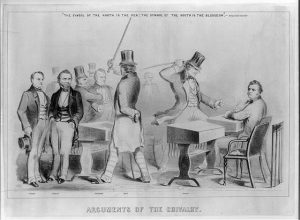Incivility in American politics has vastly increased since we first posted this article. Political violence has also surged, including domestic terrorist attacks by hate groups. It helps shed light, though it does not excuse current divisive actions, to explore periods in history when the situation was worse. Since 2016, Massachusetts and other states increased attention to K-12 civics education. Solid curriculum has also appeared. We especially recommend the Civil Discourse curriculum <https://www.tolerance.org/
"Civility in politics is a contradiction in terms," declared a historian colleague with a chuckle when I suggested the topic for a possible lecture series. Still, like most Americans, I find the current national political discourse worrisome. My history educator's mind makes me wonder, "Has it always been this way?" Well… of course, there were the Revolutionary War, Shays Rebellion, the Whiskey Rebellion, slave insurrections, the Civil War, Homestead and other labor conflicts, lynching, race riots, Stonewall riots… And despite continuing bitter words, it's hard to imagine today the equivalent of Rep. Preston Brooks'es beating of Sen. Charles Sumner on the very floor of the Senate. (See image by Winslow Homer, "Arguments of the Chivalry,"from the collections of the Library of Congress.) In actuality, by most measures, political violence has declined enormously in recent years. The Oklahoma City Bombing in 1995 marked the last large-scale eruption of wholly domestic political violence in the U.S. Deeper questions arise: - To what extent does the American Political system effectively allay violence by offering genuine change through voting and other nonviolent means? Does the system effectively balance the factions that James Madison envisioned in Federalist 10? - Do mass media today only inflame passions? Or do they also provide a vital outlet for unpopular and contrarian views? - What other factors are at play? For one source of rich debate steeped in primary sources and thoughtful analysis, I recommend the ongoing discussion on Civility on the Constitution Daily, blog of the National Constitution Center in Philadelphia. The Center is a non-partisan, non-profit organization dedicated to education and debate about citizenship and of course, our own Federal Constitution. Recent articles include "Should the people be able to veto Supreme Court decisions?" and an "opinion lab" for classroom use, asking, "Is divided government good or bad for the country?" Sign in, and speak up.




